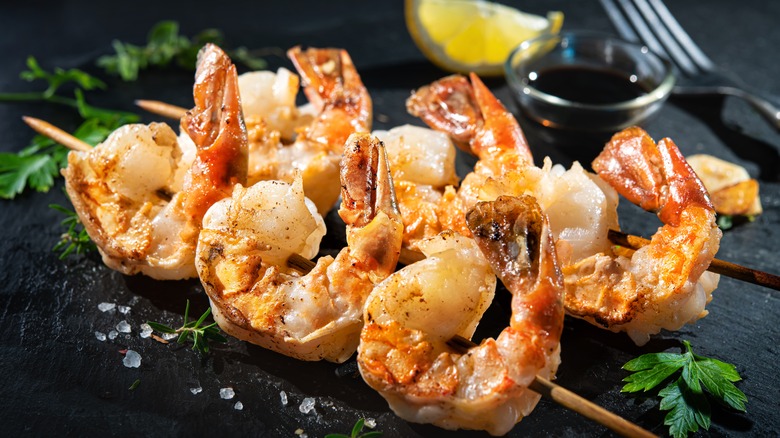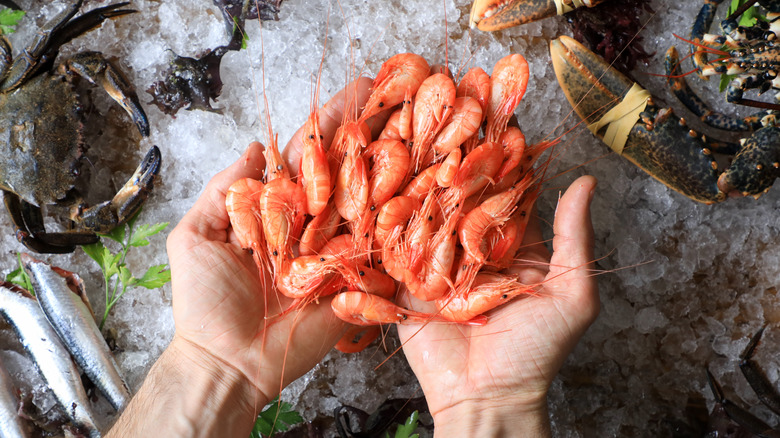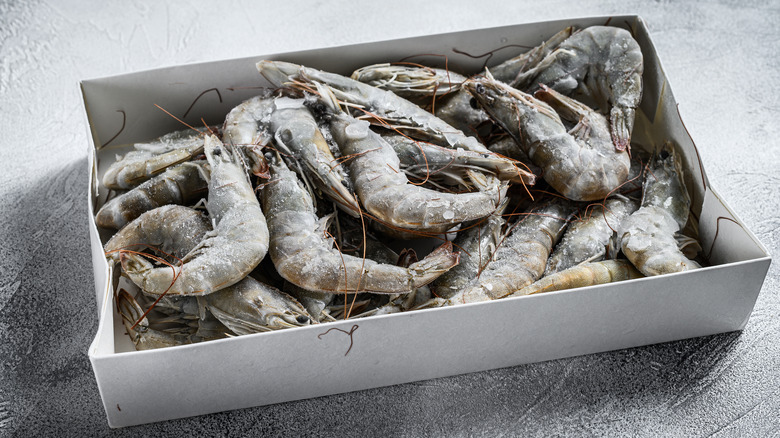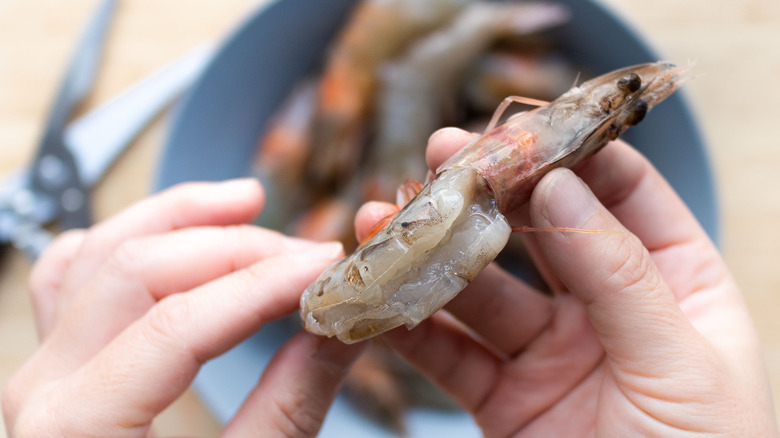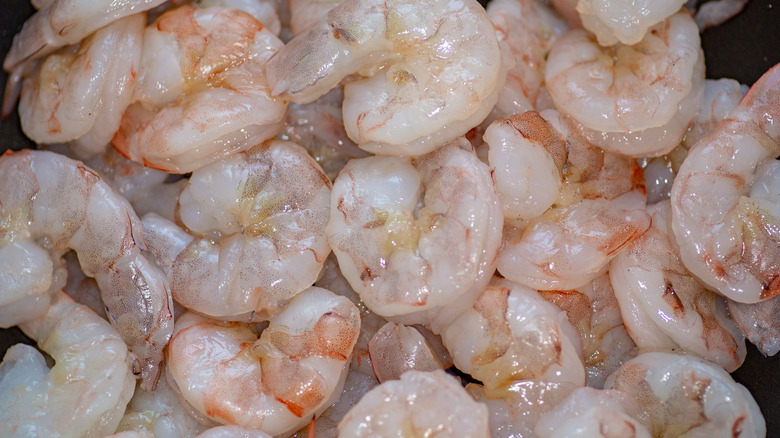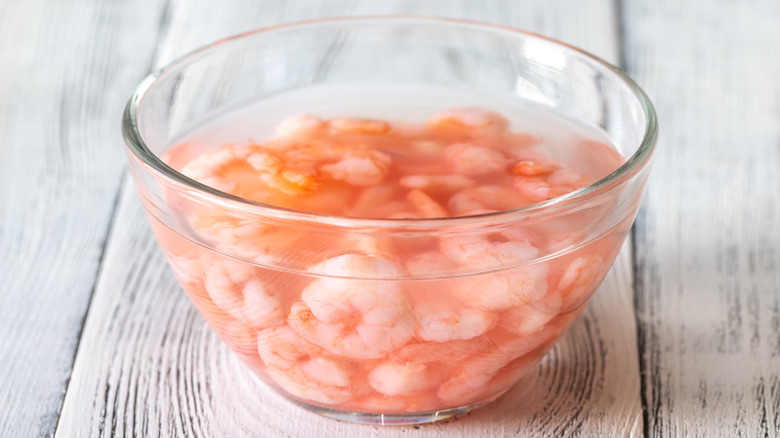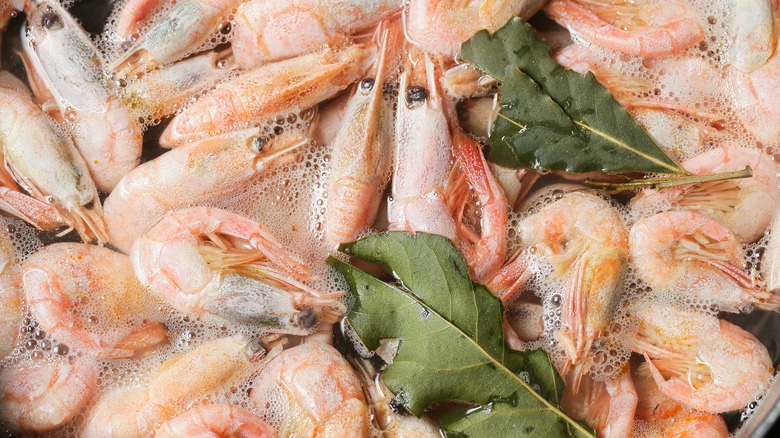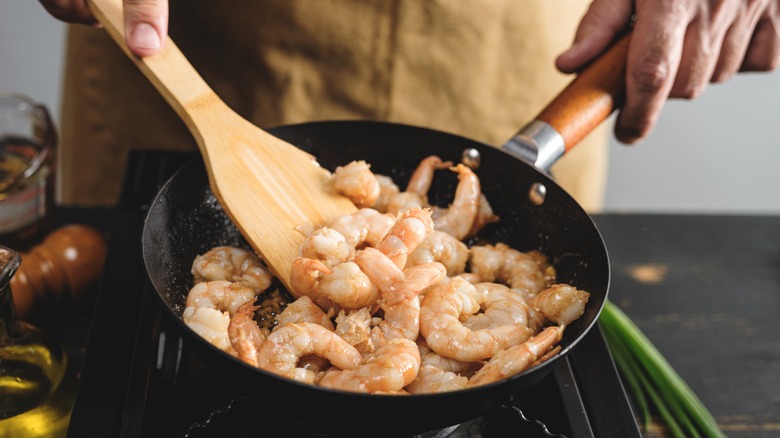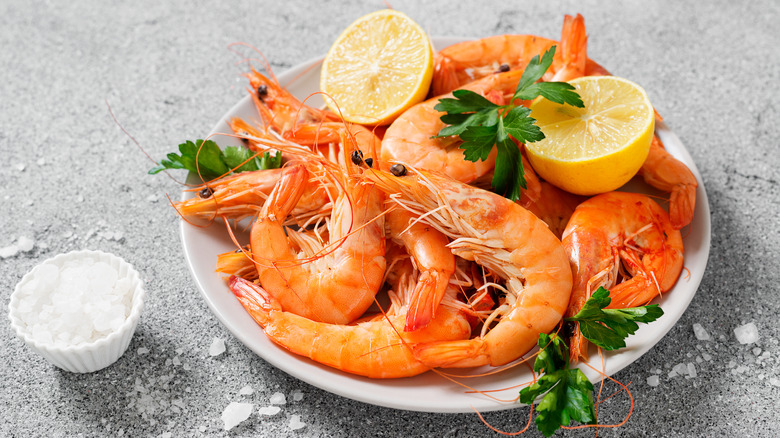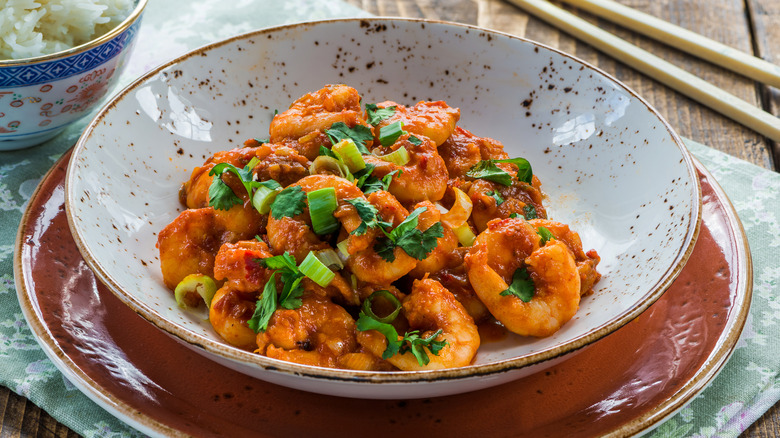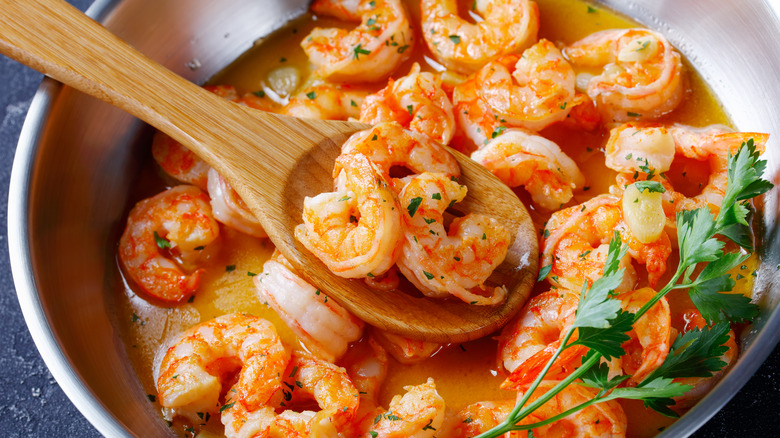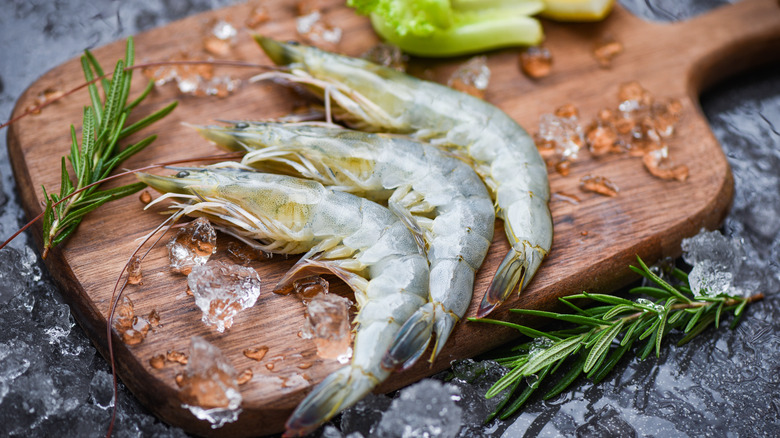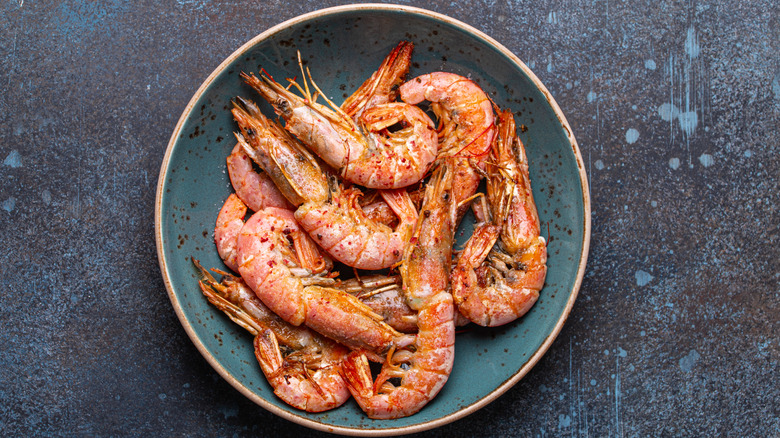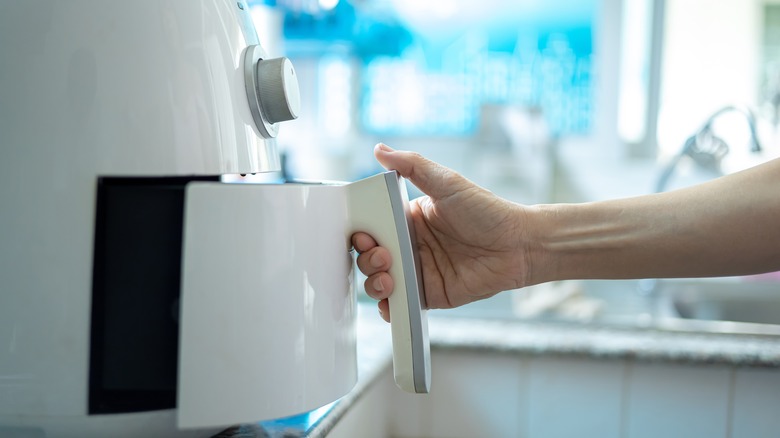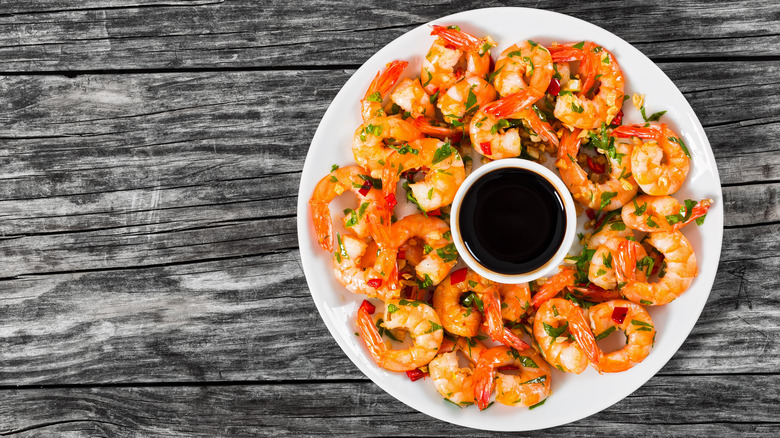16 Tips To Make Your Shrimp Taste So Much Better
If you're a shrimp lover, you're far from being alone — these delectable, sweet, and snappy shellfish are America's most popular type of seafood, and their consumption shows no signs of slowing down, according to Seafood Source. Shrimp are not only versatile and delicious, but they are also a healthy food choice, offering plenty of protein and nutrients in a relatively low-calorie package. Part of the appeal is that shrimp can be enjoyed in any way imaginable, including deep-fried, poached, and uncooked preparations like ceviche.
Whether you're creating a simple dish that enhances shrimp's natural taste or adding complex layers of intense flavor, you want to get the most out of every meaty morsel. There are a few simple pointers and guidelines to keep in mind that can ensure your shrimp are always full of flavor. We'll start by outlining how to select the best crustaceans and follow with advice on how to properly clean, cook, and flavor them. Keep these tips on hand so that every time you have a hankering for shrimp, you can guarantee they will always taste their best.
1. Start with the best quality shrimp
Shopping for shrimp can be a surprisingly daunting experience. They come in all colors and sizes, raw or pre-cooked, fresh or frozen. Some still have heads and shells while others are processed. Depending on what you have planned for your crustaceans, the ideal type of shrimp for your purpose will vary. Still, there are some general rules to follow to make sure you're selecting the right option every time.
Unless you're getting your shrimp straight out of the ocean, frozen is best. Shrimp don't stay fresh for a long time so they are usually flash-frozen the day they're caught. If you see shrimp labeled fresh, they're almost always previously frozen and defrosted by the retailer. Their so-called freshness is declining every minute they sit on the shelf unfrozen. Buying frozen shrimp means you have more control over the thawing process, which keeps the seafood in better shape until you're ready to use it. Look for the label IQF, which stands for Individually Quick Frozen, and make sure there are no chemicals or other items listed as ingredients.
Shrimp in their shells have been through the least amount of processing, which makes them a great option for that very reason. While shelled, deveined, and pre-cooked shrimp save you some work, they also give you less control over the final product. Opt for wild-caught shrimp over farmed when available, as they tend to have more flavor.
2. Defrost frozen shrimp the right way
IQF shrimp are convenient and easy to defrost. Compared with block frozen shrimp, each individual shellfish can be thawed as needed, which makes the process efficient and quick. Since shrimp are small and defrost rapidly, it's best to keep them frozen and pull them out as close to cooking time as possible. This keeps them in top shape and prevents them from becoming mushy and mealy.
If you have time to plan ahead or you've purchased block frozen shrimp, you can defrost them by placing the entire batch in the refrigerator for about 12 hours, depending on the amount and size. Otherwise, IQF shrimp can be thawed in cold water. Place them in a bowl and, if necessary, use something weighty to submerge them. It shouldn't take more than a half hour before they're defrosted and ready to go. Handle them to make sure they don't feel icy anymore, then remove them from the water to dry as thoroughly as possible before proceeding with the cooking process.
Whatever you do, don't leave shrimp out at room temperature, as this can attract dangerous bacteria (via the U.S. Food & Drug Administration). Avoid using warm or hot water for the same reason, as well as to prevent any unintentional cooking from happening.
3. Devein your shrimp
The dark line that runs along the outer edge of each shrimp is not actually a vein, but part of its digestive system. While it's not dangerous to consume, some find it visually unappealing, and it may contain sand and grit. For these reasons, it's best to remove it before cooking your shrimp to ensure the best flavor and texture.
The process is simple and can be done with a specialty tool or a simple paring knife. Whether your shrimp has a shell or not, the technique is the same: Gently slice down the center of the shrimp's back and pull on the vein with the tip of your knife to remove it in one or two pieces. If the shell is particularly rigid, kitchen shears can be utilized. Smaller shrimp can be a bit more difficult to properly devein without mangling the flesh — you can always ask your fish vendor to devein them for you if you want to make it easier on yourself.
4. Clean shrimp with potato starch
Once the shrimp have been thawed and deveined, there's an extra step you can take that's commonly used in Japanese cooking to make the shrimp especially clean, fresh, and mild tasting. All it takes is a spoonful or two of potato or cornstarch. Sprinkle it over your shrimp and distribute it with your hands. Then rinse the shrimp several times until the water runs clean. The starch helps to pull out any unseen and unwanted bits that may have made it through any initial cleaning processes, while also mellowing out fishy smells or flavors that may be present.
If you don't have starch on hand, you can simply rinse with cold water to get rid of any surface dirt, sand, or other grit that may be present on the shrimp. Just make sure to let them dry out as much as possible afterward, so you don't release too much extra moisture during the cooking process.
5. Brine your shrimp before cooking
The process of brining meat before cooking is simple and greatly improves flavor and texture. While this has become a common practice for Thanksgiving turkeys and fried chicken, it's also a useful technique to create the most flavorful shrimp possible, no matter what cooking method you plan to use for the shellfish. The main focus of brining is to make sure salt is evenly distributed through the meat so that it's fully seasoned. With shrimp, there's another ingredient you can include that aids in additional ways.
A little bit of baking soda in your brine keeps shrimp from drying out during the cooking process and ensures they have a firm yet tender texture. Scientifically, baking soda's alkaline nature creates a reaction with the shrimps' protein fibers, keeping the moisture trapped inside. This gives the shrimp a snappier, livelier texture, while the salt in the brine enhances its natural flavor. Unlike a massive holiday turkey which takes hours or days, shrimp only need 30 minutes or so to benefit from a brine, making this an easy way to maximize flavor.
6. Use a flavorful marinade
A simple salt brine will enhance the natural flavor of shrimp, but if you want a more powerful boost, you can use all kinds of herbs, spices, and aromatics to create a marinade. A quick soak in well-seasoned liquid will infuse shrimp with an extra level of deliciousness, and you can customize your marinade any way you like to suit your taste buds.
Since shrimp are small and tender, a long marinade risks adversely affecting their texture. Be particularly wary if your marinade involves acidic elements — the acidity in citrus juices like lemon and lime breaks down proteins and can actually "cook" the shrimp as they marinade. This will lead to tough, overcooked shrimp in your final dish. Unless you're making a shrimp ceviche recipe, it's best to keep contact with citrus or vinegar to a minimum before cooking.
The mild flavor of shrimp lends it plenty of versatility with other flavors, so just about any combination of herbs and spices will match up well in a marinade. Intense aromatics like garlic, ginger, and shallots pair nicely, as do fresh green herbs like dill, cilantro, and tarragon. Spice blends such as curry powders, chili powder, or Old Bay seasoning all work nicely to infuse your shrimp marinade with flavor.
7. Don't overcook your shrimp
The last thing anyone wants is tough, rubbery shrimp. Since cooking times will vary widely based on shrimp size and cooking method, it's important to keep your eyes — and nose — focused on the task at hand so that you don't ruin them. A few seconds to a minute of overcooking is all it takes to go from tender, succulent shrimp to an unpleasant, chewy mess.
If you're roasting, grilling, or pan-searing, you should cook shrimp in a single layer so that the heat is distributed evenly. If poaching or deep-frying, you want to ensure the shrimp aren't too crowded so the temperature of the water or oil stays steady. As shrimp cooks, it'll go from translucent to opaque and its color will change to shades of white, pink, and orange. The texture will go from soft to firm and springy and the shape will become more tightly curled. Using sight, touch, and smell, you should be able to determine doneness — the second the shrimp are properly cooked, remove them from heat immediately. Don't leave them in a pot or pan either, as the residual heat will keep cooking them.
8. Liven up shrimp with citrus
Citrus and seafood are a natural pairing, and shrimp are no exception. A bright burst of acidity from lime, lemon, or any other citrus fruit boosts shrimp's fresh, briny flavor and adds a fruity dimension to any dish. You can add citrus juice to a marinade or brine to flavor the shrimp before cooking (just be careful not to leave the shrimp in too long, unless you're making ceviche), or you can squeeze the juice on top once the shrimp has been prepared and plated. The zest can also be used to add flavor and aroma.
Lemon and shrimp are a classic duo — there's really no shrimp preparation that won't be improved with a little lemon juice or zest. Try the combo yourself with a lemon-garlic shrimp pasta recipe. Lime makes a great shrimp partner too, especially with Central and South American-style dishes like Chipotle lime shrimp tacos. Experiment with other citrus like orange, grapefruit, pomelo, kumquat, and yuzu — every type enhances shrimp in its own way.
9. Season shrimp boldly and generously
Shrimp has a naturally mild flavor, which makes it a versatile ingredient when it comes to cooking. You can keep it mellow by matching its mildness with minimal added ingredients — sometimes salt, pepper, and lemon are all you need. But if you want to create a dish with explosive flavor, shrimp can stand up to that too. The subtly salty, sweet meat plays well with all kinds of flavors without clashing, and the snappy, succulent texture complements every cuisine.
Indian spices like garam masala match up extremely well with shrimp — try a spicy grilled shrimp with tamarind orange chutney recipe, which showcases shrimp's affinity for piquant and tangy flavors. Shrimp features prominently in Cajun and Creole cuisines, which are all about bold flavor. You need these shellfish to round out classic dishes like jambalaya and étouffée. For a simple and fiery snack, toss shrimp in Sriracha, Buffalo sauce, or your favorite spicy condiment.
10. Poach shrimp in court bouillon
You can poach shrimp in just about any liquid, but if you want to imbue them with classic flavors, you can't go wrong with a court bouillon. In classic French cooking, court bouillon literally translates to "short broth," because unlike other stocks that can take hours or even days to prepare, this one can be made in a flash.
It's a simple combination of ingredients, but all together they create a harmonious liquid that adds a subtle dimension of flavors to anything that's poached in it. Water, wine, and citrus are simmered with mirepoix, the trio of onions, celery, and carrots that serves as a base for most classic French recipes. Herbs and spices like parsley and peppercorns are added to build more layers.
Once the broth has reached full flavor, it's cooled, strained, and stored, ready to be boiled any time you want to quickly poach some shrimp. The shellfish only need a few minutes in the boiling bouillon to cook through, and they'll be much more flavorful than if you just used water. This is a great way to prepare shrimp that are going to be served on their own, such as part of a seafood platter or shrimp cocktail.
11. Cook with fat to add richness
Shrimp have a luscious, buttery texture that matches well with rich ingredients, while their lightness and fresh bite keep them from becoming too heavy when cooked in luxurious dishes. Just like their fellow crustaceans lobster and crab, shrimp go well with butter, whether they're cooked in it or served with a butter-based sauce. This recipe for grilled shrimp adds white miso to butter for a big, bold hit of umami, while a classic shrimp scampi recipe showcases shrimp's affinity for both butter and garlic.
Butter isn't the only fat that plays well with shrimp. Bacon and shrimp are a heaven-made match, and while strips are perfect for wrapping around the shellfish, bacon fat can be utilized as well. It's a savory substance that you can use to saute shrimp for an extra meaty, smoky flavor. Experiment with other animal sources, like schmaltz and duck fat, as well as richer cooking oils like avocado and coconut oil — each one brings its unique personality and richness to shrimp.
12. Brighten shrimp with fresh herbs
The sweet, fresh flavor of shrimp pairs perfectly with green herbs picked straight from the garden (or bought from your local market). Shrimp's somewhat neutral taste means that just about any herb or combination will do — you don't need to worry about clashing or contrasting flavors or aromas. You can go light and bright or deep and savory; simply focus on one particular herb or a mixture, and chances are you won't be disappointed.
A blend of Provençal herbs like rosemary, thyme, parsley, and oregano brings a sunny Mediterranean flavor to shrimp. Since these shellfish don't take long to cook, fresh herbs will retain their bright flavor. Delicate herbs like dill and chervil can be added near the end of the cooking process or as a garnish. This will prevent their subtle flavor and aroma from getting lost in the heat. Basil and tarragon leaves give shrimp a pleasant sharp punch of flavor. Cilantro is another great choice, especially when paired with a fresh squeeze of lime.
13. Keep the shells on
If you've ever made shrimp stock, you know that shrimp shells are full of sweet and savory flavor. But you don't need to use them only for stock. Leaving shrimp in their shells while cooking has a lot of advantages, and it will ensure that you end up with the most tender, flavor-packed shrimp possible, no matter what cooking method you use.
Keeping the shells on your shrimp protects the meat from overcooking and keeps moisture trapped inside so it doesn't dry out. Because shrimp cook in such a short amount of time, this gives you a wider window, which is especially helpful if you're cooking with direct heat, such as grilling and pan-searing. The makeup of the shells themselves also adds an extra flavor — browned shells infuse a satisfying roasted flavor to the meat inside, as well as a hit of umami.
You can even eat shrimp shells under the right conditions — the smaller the shrimp the better, as their shells tend to be lighter and more tender. A crispy-fried shell adds a crunchy textural punch to shrimp, which is a great contrast to the moist and tender meat inside.
14. Cook shrimp in an air fryer
The air fryer is one of the most versatile small appliances in the kitchen, and when it comes to shrimp, this method of cooking is hard to beat. Any size, cuisine, or preparation style can be accommodated with an air fryer, and in most cases you'll save time, effort, and have an easier clean-up than you would with other methods. But most importantly, air frying shrimp gives these little crustaceans great taste and texture.
If you love crispy, crunchy, breaded and golden-fried shrimp — think delectable treats like coconut shrimp and popcorn shrimp — but hate the hot, oily mess of deep frying, the air fryer is your salvation. Shrimp don't need to be breaded to benefit from air frying, though. Marinated or spice-rubbed shrimp, fresh or frozen, shells on or off, anything goes in an air fryer. Cooking times will vary depending on the recipe and the size of the shrimp. To know if your air-fried shrimp are cooked properly, along with plenty of other helpful tips, check out our handy guide to cooking shrimp.
15. Butterfly the shrimp
The butterfly technique is an excellent knife skill to learn. You can increase the flavor and texture potential of shrimp with the simple flick of a blade, and give your dish a more polished and pretty appearance. If you've never butterflied a protein before, shrimp are a great place to start thanks to their bonelessness, small size, and simple anatomy. Keep in mind that this technique is best suited for larger sized shrimp, as they need to be meaty enough to hold together when sliced down the middle.
All you need is a paring knife to make one continuous cut from the shrimp's head to its tail, making sure not to go too deep, as you want the shrimp to remain in one piece. Once the cut is made, spread the two halves open like a butterfly's wings. Your shrimp now has double the amount of surface area, which means it can take on more seasoning and has more exposure to heat. This means not only will the shrimp have more texture, it'll also cook quicker and more evenly. This improvement is particularly evident with direct heat methods like pan-searing and grilling, but you can butterfly shrimp for any cooking technique. We've got plenty of scrumptious shrimp recipes to inspire you.
16. Boost flavor with dipping sauce
Shrimp were put on this earth to be dipped. Why else would they consist of a bite-sized body of succulent, juicy meat attached to a handy tail, the perfect size and shape to grasp with two fingers? And thanks to their mellow flavor, shrimp can take on all manner of accompaniments: Sweet and spicy, fiery and mild, delicate and bold, making them the perfect vessels for all of your favorite sauces and condiments. The famed shrimp cocktail is the best-known example of this culinary crustacean's exceptional dippability. While the classic horseradish-based condiment is a flawless pairing with shrimp, there are countless exciting variations — you can add pickle juice to cocktail sauce for a salty punch, or fresh minced chiles to kick up the heat.
Venturing out of the cocktail sauce zone, you'll find that just about any dip plays well with shrimp. Tangy seafood-friendly dips like tartar sauce and thousand island are no-brainers. Try herb-forward sauces like green goddess dressing, or anything with lemon or garlic, to enhance the shrimp's bright fresh flavor. Since shrimp have a natural sweetness to them, dipping sauces with fruit or honey are beautifully complementary. To pack each bite with umami, let your shrimp take a dip in ingredients like soy sauce or tamari.
